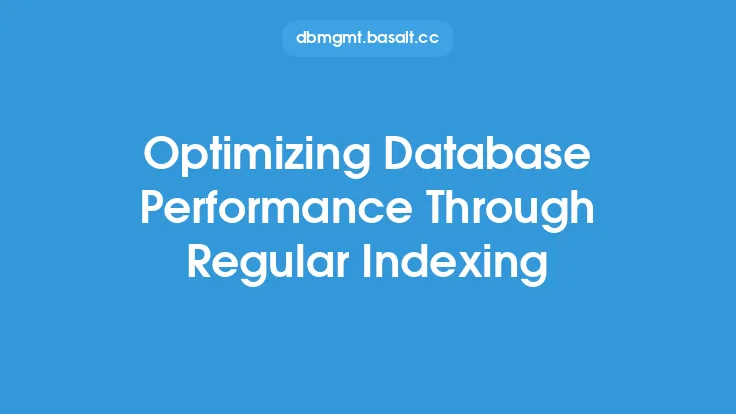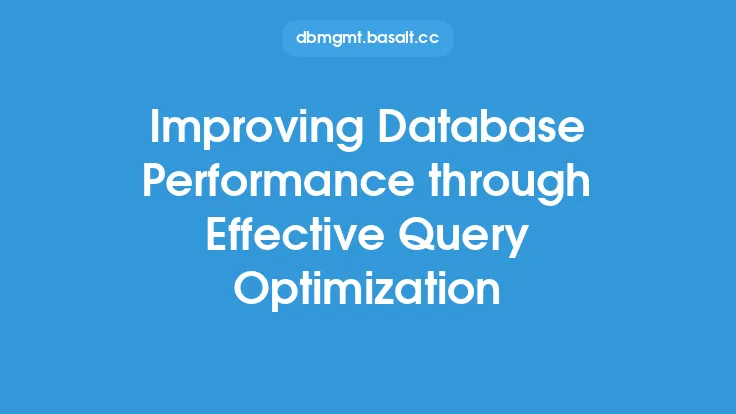When it comes to optimizing database performance, there are several factors to consider, and one crucial aspect is effective data formatting. Properly formatted data can significantly improve the efficiency and speed of database operations, leading to better overall performance. In this article, we will delve into the world of data formatting and explore how it can be used to optimize database performance.
Introduction to Data Formatting
Data formatting refers to the process of organizing and structuring data in a way that makes it easily readable and accessible to both humans and machines. This involves using standardized formats, such as dates, times, and numerical values, to ensure consistency and accuracy throughout the database. Effective data formatting is essential for maintaining data integrity, reducing errors, and improving data analysis and reporting.
Benefits of Effective Data Formatting
Effective data formatting offers numerous benefits, including improved data readability, reduced data redundancy, and enhanced data analysis capabilities. When data is properly formatted, it becomes easier to identify patterns, trends, and correlations, making it simpler to extract insights and make informed decisions. Additionally, well-formatted data reduces the risk of errors and inconsistencies, which can lead to incorrect conclusions and poor decision-making.
Data Type Selection
One of the most critical aspects of data formatting is selecting the appropriate data type for each column or field. Different data types, such as integers, strings, and dates, have varying storage requirements and processing speeds. Choosing the correct data type can significantly impact database performance, as it affects the amount of storage space required and the speed of data retrieval. For example, using an integer data type for a column that stores numerical values can be more efficient than using a string data type, as integers require less storage space and can be processed faster.
Data Normalization
Data normalization is the process of organizing data in a database to minimize data redundancy and dependency. Normalization involves dividing large tables into smaller, more manageable tables, and linking them through relationships. This process helps to eliminate data duplication, reduce data inconsistencies, and improve data integrity. Normalization also makes it easier to maintain and update data, as changes only need to be made in one place. There are several normalization techniques, including first normal form (1NF), second normal form (2NF), and third normal form (3NF), each with its own set of rules and guidelines.
Indexing and Constraints
Indexing and constraints are two essential components of data formatting that can significantly impact database performance. Indexing involves creating a data structure that improves the speed of data retrieval, while constraints are used to enforce data integrity and consistency. Indexes can be created on columns or fields that are frequently used in queries, such as primary keys or foreign keys, to speed up data retrieval. Constraints, on the other hand, can be used to enforce rules, such as uniqueness, nullability, and data type consistency, to ensure data accuracy and integrity.
Data Compression and Encryption
Data compression and encryption are two techniques that can be used to improve data formatting and database performance. Data compression involves reducing the size of data to save storage space and improve data transfer speeds. Encryption, on the other hand, involves converting data into a secure, unreadable format to protect it from unauthorized access. Both techniques can be used to improve data security and reduce storage requirements, but they can also impact database performance, as they require additional processing power and resources.
Best Practices for Data Formatting
To optimize database performance through effective data formatting, several best practices should be followed. These include using standardized formats, selecting the appropriate data type, normalizing data, indexing and constraining data, and compressing and encrypting data. Additionally, data should be regularly backed up and validated to ensure data integrity and consistency. By following these best practices, databases can be optimized for performance, and data can be made more readable, accessible, and secure.
Tools and Technologies for Data Formatting
Several tools and technologies are available to support data formatting, including database management systems (DBMS), data modeling tools, and data integration platforms. DBMS, such as MySQL and Oracle, provide features and functions for data formatting, including data type selection, indexing, and constraining. Data modeling tools, such as Entity-Relationship diagrams, can be used to design and visualize database structures, while data integration platforms, such as ETL (Extract, Transform, Load) tools, can be used to extract, transform, and load data from various sources.
Conclusion
In conclusion, effective data formatting is a critical aspect of optimizing database performance. By using standardized formats, selecting the appropriate data type, normalizing data, indexing and constraining data, and compressing and encrypting data, databases can be optimized for performance, and data can be made more readable, accessible, and secure. By following best practices and using the right tools and technologies, data formatting can be used to improve database performance, reduce errors, and enhance data analysis and reporting capabilities. As data continues to play an increasingly important role in business decision-making, the importance of effective data formatting will only continue to grow.





